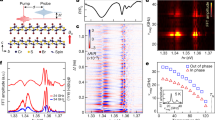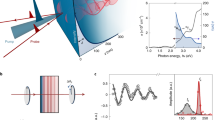Abstract
Magnonics concepts utilize spin-wave quanta (magnons) for information transmission, processing and storage. To convert information carried by magnons into an electric signal promises compatibility of magnonic devices with conventional electronic devices, that is, magnon spintronics1. Magnons in inorganic materials have been studied widely with respect to their generation2,3, transport4,5 and detection6. In contrast, resonant spin waves in the room-temperature organic-based ferrimagnet vanadium tetracyanoethylene (V(TCNE) x (x ≈ 2)), were detected only recently7. Herein we report room-temperature coherent magnon generation, transport and detection in films and devices based on V(TCNE) x using three different techniques, which include broadband ferromagnetic resonance (FMR), Brillouin light scattering (BLS) and spin pumping into a Pt adjacent layer. V(TCNE) x can be grown as neat films on a large variety of substrates, and it exhibits extremely low Gilbert damping comparable to that in yttrium iron garnet. Our studies establish an alternative use for organic-based magnets, which, because of their synthetic versatility, may substantially enrich the field of magnon spintronics.
This is a preview of subscription content, access via your institution
Access options
Access Nature and 54 other Nature Portfolio journals
Get Nature+, our best-value online-access subscription
$29.99 / 30 days
cancel any time
Subscribe to this journal
Receive 12 print issues and online access
$259.00 per year
only $21.58 per issue
Buy this article
- Purchase on Springer Link
- Instant access to full article PDF
Prices may be subject to local taxes which are calculated during checkout



Similar content being viewed by others
References
Chumak, A. V., Vasyuchka, V. I., Serga, A. A. & Hillebrands, B. Magnon spintronics. Nat. Phys. 11, 453–461 (2015).
Collet, M. et al. Generation of coherent spin-wave modes in yttrium iron garnet microdiscs by spin–orbit torque. Nat. Commun. 7, 10377 (2016).
Jungfleisch, M. B. et al. Large spin-wave bullet in a ferrimagnetic insulator driven by the spin Hall effect. Phys. Rev. Lett. 116, 057601 (2016).
Kajiwara, Y. et al. Transmission of electrical signals by spin-wave interconversion in a magnetic insulator. Nature 464, 262–266 (2010).
Cornelissen, L. J., Liu, J., Duine, R. A., Youssef, J. B. & van Wees, B. J. Long-distance transport of magnon spin information in a magnetic insulator at room temperature. Nat. Phys. 11, 1022–1026 (2015).
Saitoh, E., Ueda, M., Miyajima, H. & Tatara, G. Conversion of spin current into charge current at room temperature: inverse spin-Hall effect. Appl. Phys. Lett. 88, 182509 (2006).
Zhu, N. et al. Low loss spin wave resonances in organic-based ferrimagnet vanadium tetracyanoethylene thin films. Appl. Phys. Lett. 109, 082402 (2016).
Bauer, G. E. W., Saitoh, E. & van Wees, B. J. Spin caloritronics. Nat. Mater. 11, 391–399 (2012).
Demidov, V. E. et al. Magnetic nano-oscillator driven by pure spin current. Nat. Mater. 11, 1028–1031 (2012).
Bauer, H. G., Chauleau, J. Y., Woltersdorf, G. & Back, C. H. Coupling of spinwave modes in wire structures. Appl. Phys. Lett. 104, 102404 (2014).
An, T. et al. Unidirectional spin-wave heat conveyer. Nat. Mater. 12, 549–553 (2013).
Mosendz, O. et al. Quantifying spin Hall angles from spin pumping: experiments and theory. Phys. Rev. Lett. 104, 046601 (2010).
Uchida, K. et al. Spin Seebeck insulator. Nat. Mater. 9, 894–897 (2010).
Chumak, A. V., Serga, A. A. & Hillebrands, B. Magnon transistor for all-magnon data processing. Nat. Commun. 5, 4700 (2014).
Ellsworth, D. et al. Photo-spin-voltaic effect. Nat. Phys. 12, 861–866 (2016).
Plachy, R. et al. Ferrimagnetic resonance in films of vanadium [tetracyanoethanide] x , grown by chemical vapor deposition. Phys. Rev. B 70, 064411 (2004).
Yu, H. et al. Ultra-narrow ferromagnetic resonance in organic-based thin films grown via low temperature chemical vapor deposition. Appl. Phys. Lett. 105, 012407 (2014).
Miller, J. S. Oliver Kahn Lecture: Composition and structure of the V[TCNE] x (TCNE = tetracyanoethylene) room-temperature, organic-based magnet—a personal perspective. Polyhedron 28, 1596–1605 (2009).
Pokhodnya, K. I., Epstein, A. J. & Miller, J. S. Thin-film V[TCNE] x magnets. Adv. Mater. 12, 410–413 (2000).
Manriquez, J. M., Yee, G. T., McLean, R. S., Epstein, A. J. & Miller, J. S. A room-temperature molecular/organic-based magnet. Science 252, 1415–1417 (1991).
Yoo, J.-W. et al. Spin injection/detection using an organic-based magnetic semiconductor. Nat. Mater. 9, 638–642 (2010).
Fang, L. et al. Electrical spin injection from an organic-based ferrimagnet in a hybrid organic–inorganic heterostructure. Phys. Rev. Lett. 106, 156602 (2011).
Xiong, Z. H., Wu, D., Valy Vardeny, Z. & Shi, J. Giant magnetoresistance in organic spin-valves. Nature 427, 821–824 (2004).
Dediu, V. A., Hueso, L. E., Bergenti, I. & Taliani, C. Spin routes in organic semiconductors. Nat. Mater. 8, 707–716 (2009).
Ando, K. et al. Electrically tunable spin injector free from the impedance mismatch problem. Nat. Mater. 10, 655–659 (2011).
Ando, K., Watanabe, S., Mooser, S., Saitoh, E. & Sirringhaus, H. Solution-processed organic spin–charge converter. Nat. Mater. 12, 622–627 (2013).
Watanabe, S. et al. Polaron spin current transport in organic semiconductors. Nat. Phys. 10, 308–313 (2014).
Koopmans, B. Organic spintronics: pumping spins through polymers. Nat. Phys. 10, 249–250 (2014).
Sun, D. et al. Inverse spin Hall effect from pulsed spin current in organic semiconductors with tunable spin-orbit coupling. Nat. Mater. 15, 863–869 (2016).
Kittel, C. On the theory of ferromagnetic resonance absorption. Phys. Rev. 73, 155–161 (1948).
Tserkovnyak, Y., Brataas, A. & Bauer, G. E. W. Enhanced Gilbert damping in thin ferromagnetic films. Phys. Rev. Lett. 88, 117601 (2002).
Jungfleisch, M. B. et al. Thickness and power dependence of the spin-pumping effect in Y3Fe5O12/Pt heterostructures measured by the inverse spin Hall effect. Phys. Rev. B 91, 134407 (2015).
Rojas-Sánchez, J. C. et al. Spin pumping and inverse spin Hall effect in platinum: the essential role of spin-memory loss at metallic interfaces. Phys. Rev. Lett. 112, 106602 (2014).
Froning, I. H. et al. Thin-film encapsulation of the air-sensitive organic-based ferrimagnet vanadium tetracyanoethylene. Appl. Phys. Lett. 106, 122403 (2015).
Acknowledgements
This work was supported by NSF grant no. DMR-1701427 (p-ISHE measurements), MURI-AFOSR grant FA9550-14-1-0037 (cw ISHE and FMR measurements) and NSF MRSEC grant no. DMR-1121252 (the V(TCNE) x synthesis and film growth). All the authors contributed to the preparation of the manuscript.
Author information
Authors and Affiliations
Contributions
Z.V.V., C.B. and J.S.M. were responsible for the project planning, group management and final writing of the manuscript. H.L., C.Z., R.A.D., R.M. and J.H. prepared the organic magnetic films. H.L., C.Z., S.J. and D.S. prepared the ISHE devices. R.A.D. measured the critical temperature using SQUID. H.L., M.G. and D.S. measured the Gilbert damping and inverse spin Hall response using cw MW excitation. H.L. and C.Z. measured the non-thermal magnons using BLS. H.M. and M.K. measured the inverse spin Hall response by pulse MW. All the authors contributed to the results, analysis, discussion and manuscript preparation.
Corresponding author
Ethics declarations
Competing interests
The authors declare no competing interests.
Additional information
Publisher’s note: Publisher’s note: Springer Nature remains neutral with regard to jurisdictional claims in published maps and institutional affiliations.
Supplementary information
Supplementary Information
Supplementary text, Figures S1–S9, 13 references
Rights and permissions
About this article
Cite this article
Liu, H., Zhang, C., Malissa, H. et al. Organic-based magnon spintronics. Nature Mater 17, 308–312 (2018). https://doi.org/10.1038/s41563-018-0035-3
Received:
Accepted:
Published:
Issue Date:
DOI: https://doi.org/10.1038/s41563-018-0035-3
This article is cited by
-
Reconfigurable spin current transmission and magnon–magnon coupling in hybrid ferrimagnetic insulators
Nature Communications (2024)
-
Molecular magneto-ionic proton sensor in solid-state proton battery
Nature Communications (2022)
-
Modulation of spin dynamics in Ni/Pb(Mg1/3Nb2/3)O3-PbTiO3 multiferroic heterostructure
Journal of Advanced Ceramics (2022)
-
Advances in coherent magnonics
Nature Reviews Materials (2021)
-
A scalable molecule-based magnetic thin film for spin-thermoelectric energy conversion
Nature Communications (2021)



